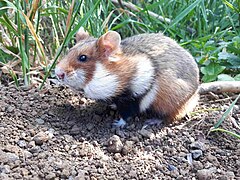Chomik (rodzaj)
| Cricetus | |||
| Leske, 1779[1] | |||
 Przedstawiciel rodzaju – chomik europejski (C. cricetus) | |||
| Systematyka | |||
| Domena | |||
|---|---|---|---|
| Królestwo | |||
| Typ | |||
| Podtyp | |||
| Gromada | |||
| Podgromada | |||
| Rząd | |||
| Podrząd | |||
| Infrarząd | |||
| Nadrodzina | |||
| Rodzina | |||
| Podrodzina | |||
| Rodzaj |
chomik | ||
| Typ nomenklatoryczny | |||
|
Mus cricetus Linnaeus, 1758 | |||
| Synonimy | |||
|
| |||
| Gatunki | |||
| |||
Chomik[4] (Cricetus) – rodzaj ssaków z podrodziny chomików (Cricetinae) w obrębie rodziny chomikowatych (Cricetidae).
Zasięg występowania
Rodzaj obejmuje jeden żyjący współcześnie gatunek występujący w Eurazji[5][6].
Morfologia
Długość ciała (bez ogona) samic 165–270 mm, samców 175–320 mm, długość ogona samic 27–68 mm, samców 33–68; masa ciała samic 146–600 g, samców 158–860 g[7][8].
Systematyka
Rodzaj zdefiniował w 1779 roku niemiecki przyrodnik Nathanael Gottfried Leske w książce swojego autorstwa o tytule Anfangsgründe der Naturgeschichte[1]. Na gatunek typowy Leske wyznaczył chomika europejskiego (C. cricetus).
Etymologia
- Cricetus: wł. criceto ‘chomik’[9].
- Hamster: niem. hamster ‘chomik’[10]. Gatunek typowy: Hamster nigricans Lacépède, 1799 (= Mus cricetus Linnaeus, 1758).
- Heliomys: gr. ἡλιος hēlios ‘słońce’; μυς mus, μυος muos ‘mysz’[11]. Gatunek typowy: Heliomys jeudei J.E. Gray, 1873 (= Mus cricetus Linnaeus, 1758).
Podział systematyczny
Do rodzaju należy jeden występujący współcześnie gatunek[12][8][5][4]:
- Cricetus cricetus (Linnaeus, 1758) – chomik europejski
Opisano również gatunki wymarłe:
- Cricetus lophidens De Bruijn, Dawson & Mein, 1970[13] (Grecja; pliocen)
- Cricetus major Woldřich, 1880[14] (Czechy; plejstocen)
- Cricetus nanus Schaub, 1930[15] (Rumunia; plejstocen)
- Cricetus praeglacialis Schaub, 1930[16] (Węgry; plejstocen)
- Cricetus runtonensis Newton, 1909[17] (Wielka Brytania; plejstocen)
Przypisy
- ↑ a b N.G. Leske: Anfangsgründe der Naturgeschichte. Cz. 1. Leizpizg: bei Siegrfried Lebrecht Trufius, 1779, s. 168. (niem.).
- ↑ B.G. de Lacépède: Tableau des divisions, sous-divisions, ordres et genres des mammifères. W: B.G. de Lacépède: Discours d’ouverture et de clôture du cours d’histoire naturelle, donné dans le Muséum national d’Histoire naturelle, l’an VII de la République, et tableaux méthodiques des mammifères et des oiseaux. Paris: Plassan, 1799, s. 10. (fr.).
- ↑ J.E. Gray. Notes on the rats; with the description of some new species from Panama and the Aru Islands. „The Annals and Magazine of Natural History”. Fourth series. 12 (21), s. 417, 1873. (ang.).
- ↑ a b Nazwy polskie za: W. Cichocki, A. Ważna, J. Cichocki, E. Rajska-Jurgiel, A. Jasiński & W. Bogdanowicz: Polskie nazewnictwo ssaków świata. Warszawa: Muzeum i Instytut Zoologii PAN, 2015, s. 239. ISBN 978-83-88147-15-9. (pol. • ang.).
- ↑ a b C.J. Burgin, D.E. Wilson, R.A. Mittermeier, A.B. Rylands, T.E. Lacher & W. Sechrest: Illustrated Checklist of the Mammals of the World. Cz. 1: Monotremata to Rodentia. Barcelona: Lynx Edicions, 2020, s. 340. ISBN 978-84-16728-34-3. (ang.).
- ↑ D.E. Wilson & D.M. Reeder (redaktorzy): Genus Cricetus. [w:] Mammal Species of the World. A Taxonomic and Geographic Reference (Wyd. 3) [on-line]. Johns Hopkins University Press, 2005. [dostęp 2023-02-05].
- ↑ U. Pardiñas, P. Myers, L. León-Paniagua, N.O. Garza, J. Cook, B. Kryštufek, R. Haslauer, R. Bradley, G. Shenbrot & J. Patton. Opisy gatunków Cricetidae: U. Pardiñas, D. Ruelas, J. Brito, L. Bradley, R. Bradley, N.O. Garza, B. Kryštufek, J. Cook, E.C. Soto, J. Salazar-Bravo, G. Shenbrot, E. Chiquito, A. Percequillo, J. Prado, R. Haslauer, J. Patton & L. León-Paniagua: Family Cricetidae (True Hamsters, Voles, Lemmings and New World Rats and Mice). W: D.E. Wilson, R.A. Mittermeier & T.E. Lacher (red. red.): Handbook of the Mammals of the World. Cz. 7: Rodents II. Barcelona: Lynx Edicions, 2017, s. 286. ISBN 978-84-16728-04-6. (ang.).
- ↑ a b Class Mammalia. W: Lynx Nature Books: All the Mammals of the World. Barcelona: Lynx Edicions, 2023, s. 221. ISBN 978-84-16728-66-4. (ang.).
- ↑ Palmer 1904 ↓, s. 203.
- ↑ Palmer 1904 ↓, s. 308.
- ↑ Palmer 1904 ↓, s. 314.
- ↑ N. Upham, C. Burgin, J. Widness, M. Becker, C. Parker, S. Liphardt, I. Rochon & D. Huckaby: Treeview of Mammalian Taxonomy Hierarchy. [w:] ASM Mammal Diversity Database (Version 1.11) [on-line]. American Society of Mammalogists. [dostęp 2023-10-03]. (ang.).
- ↑ H. de Bruijn, M.R. Dawson & P. Mein. Upper Pliocene Rodentia, Lagomorpha and Insectivora (Mammalia) from the Isle of Rhodes (Greece). „Proceedings of the Koninklijke Nederlandse Akademie van Wetenschappen”. Series B. 73 (5), s. 552, 1970. (ang.).
- ↑ J.N. Woldřich. Diluviale Fauna von Zuzlawitz bei Winterberg im Böhmerwalde. „Sitzungsberichte der Kaiserlichen Akademie der Wissenschaften. Mathematisch-Naturwissenschaftliche Classe”. Abt. 1 Mineralogie, Botanik, Zoologie, Geologie und Paläontologie. 82, s. 31, 1881. (niem.).
- ↑ Schaub 1930 ↓, s. 30.
- ↑ Schaub 1930 ↓, s. 28.
- ↑ E.T. Newton. Hamster remains from the Norfolk Forest Bed. „The geological magazine, or, Monthly journal of geology”. New series. Decade V. 6, s. 113, 1909. (ang.).
Bibliografia
- T.S. Palmer. Index Generum Mammalium: a List of the Genera and Families of Mammals. „North American Fauna”. 23, s. 1–984, 1904. (ang.).
- S. Schaub. Quartäre und jungtertiäre Hamster. „Abhandlungen der schweizerischen paläontologischen Gesellschaft”. 49, s. 1–49, 1930. (niem.).
